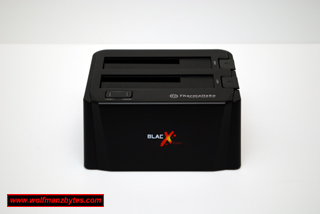
First a big thank you to Thermaltake for providing the BlacX Duet Docking Station for this Review.
A while ago I had the chance to Review the BlacX hard drive dock and was pretty impressed with it, today I take a look at the BlacX Duet hard drive dock and see what it has to offer over the BlacX.
Before I get too far into this Review I should mention the features of the BlacX Duet and they are the following.
Features
-Enclosure Interface: eSATA. USB 2.0
-Transfer Rate: eSATA: up to 3Gbps, USB 2.0: up to 480Mbps
-HDD Compatible: SATA I, SATA II
-HDD Capacity: All 2.5” or 3.5” SATA HDD up to 2TB (per slot)
-OS Compatible: Windows 7 / Vista / XP / 2003 / 2000, Mac 10.3 and later
-Material: ABS Plastic
-Power: Input: 100-240V / 50-60Hz ; Output: 12V / 2A
-Dimension: 140 (W) 120.82 (D) x 69.49 (H) mm 5.51 (W) x 4.76 (D) x 2.74 (H) in
-Accessory: eSATA Cable, USB 2.0 Cable, Power Adaptor
-Weight: 312 g / 0.69 lbs
Special Features
-Copy & Transfer data between Hard Drives & Computers
-Hot-Swap Capability for Rapid Multi HDDs Access & Exchange
-Compact Docking Station Design maximizes Heat Dissipation & Exhaust
-Supports eSATA Transfer Speed up to 3Gbps
The first thing you notice about the BlacX Duet over the BlacX docking station that I previously reviewed here is that, the BlacX Duet comes with two slots in order for it to handle two hard drives at once where the BlacX only has one slot and could only work with one hard drive at a time.
The other nice feature of the BlacX Duet is that unlike the BlacX model the BlacX Duet also has an eSATA connection to go along with its USB 2.0 connection. The eSATA connection is what most people will want to use if they want the maximum speed out of their hard drives do to the fact it’s a lot faster than USB 2.0 connection.
One issue people may run into while trying to use the eSATA connection is that unless your motherboard supports Port Multiplexing you will only be able to see one of the two drives that are connected to the BlacX Duet when you’re in Windows. I had several older machines that I tested the BlacX Duet on and none of them could see the second drive in the dock while using the eSATA connection and this was due to the lack of port multiplexing on the motherboards that were only a few years old. Also it turns out a lot of Intel based motherboards don’t support Port Multiplexing at all. If your motherboard does not support Port Multiplexing you can always fall back to the USB 2.0 connection and with that you can see both drives in the dock however, you will be stuck with USB 2.0 speed instead of the blistering eSATA speed.
On the performance side of things, when transferring files from a hard drive in the BlacX Duet to my computer over USB 2.0 I would get a transfer rate of about 30 Megabytes per second. When I switched over to the eSATA connection that transfer rate shot up to about 60 Megabytes per second and that was on a rather slow hard drive. If you plug an SSD drive into this dock using eSATA then you will really see the benefit of eSATA do to how fast some SSD can be.
As for its looks, the BlacX Duet looks the same as the BlacX with just another slot in it for the second hard drive. As I said about the BlacX when I Reviewed that I like these types of drive docks because they make swapping the hard drives in and out super easy. Another benefit of the BlacX docks is that you don’t have any heat issues since the drives are not in a confined closed space as you would see with some external drive enclosures.
The other nice feature of the BlacX Duet is it supports the hot swapping of hard drives and that means you can swap drives in and out of the dock without rebooting the computer all the time and that’s a good thing.
In this next picture you can see that I have the BlacX duet loaded up with a 1TB spindle based hard drive as well as 256 Gig 2.5” SSD. If you look at the left front of the BlacX Duet you can see the switch that turns it off and on. On the switch you also have two blue led lights (one for each drive) that will light up when there is drive activity. Looking off to the right hand side of the drives you’ll see that you have two black eject buttons and these are used to eject the hard drives out of the BlacX Duet.
When you look at the back of the BlacX Duet you will notice this is where the various IO connections are along with the power adapter jack and you can see this in the picture below.
In conclusion I think overall the BlacX Duet is a pretty slick solution if you’re in the need for a drive dock that can handle two drives at once. One thing I would like to see on the BlacX Duet would be a USB 3.0 connection. Overall I was fairly impressed with how the BlacX Duet handled two hard drives while using the USB 2.0 connection. The only real downside to the BlacX Duet is the Port Multiplexing issue that I mentioned above. At the time of this Review you could purchase the Thermaltake BlacX Duet for around $50.00 U.S.
Below are a few more pictures of the BlacX Duet Enjoy!










